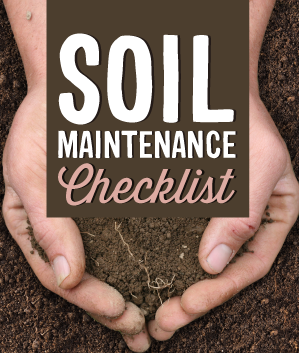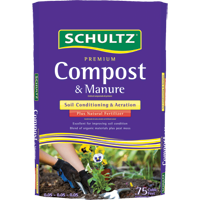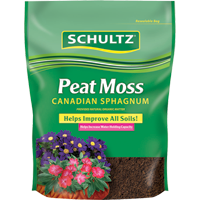
A garden is only as good as it’s soil. Find out if you are properly maintaining your soil with our simple checklist.
Add Compost: No matter the soil type, adding compost improves the overall soil structure. Mix 2”-3” of compost into the top layer of your native soil. Compost aerates clay soils by forcing tightly packed particles apart. It also improves moisture and nutrient retention in sandy soils by lodging itself into large pore spaces slowing the soil drainage. We suggest using Schultz Premium Compost & Manure for conditioning, aerating, improving soil conditions and balancing the blend of organic materials.
Use Soil Amendments: A soil amendment is any material added to a soil to improve its physical and chemical qualities, especially its ability to provide a good root zone environment for plants. Physical qualities of soil include permeability, water-holding capacity, porosity, and texture. The goal of amendments is to provide a better environment for roots. Soil amendments include a wide range of fertilizers, organic and non-organic materials. Learn how to classify the type of soil in your yard, what soil amendments to use, proper soil maintenance, and gardening tips.
Aerating: This is the process of puncturing numerous holes in the ground with either a rod or an automatic machine at a depth of 2 to 3 inches. Once you are finished, it is a great time to fertilize or overseed to improve the overall health and beauty of your lawn. Topdressing, after aerating, with organic material like compost or peat moss improves soil structure for stronger turf in the long-run. Aerating is always a good idea when you have soil compaction as it is extremely effective in loosening the soil. Aeration creates a healthy root zone by increasing air space and allows water and fertilizer penetration to reach the roots. The optimal time for warm season grasses is in the spring/early summer, while cool season grasses flourish in the fall. Be sure to give your lawn time to repair
before cool season dormancy occurs.
Plant a Cover Crop: Cover crops aerate the native soil with their root systems by pulling nutrients from deep within to the top layer of soil, making nutrients readily available for new plant life. Plant a cover crop in an area where you want to plant the following season. Till your cover crop 2-3 weeks before you plan to plant to increase the organic matter and nutrients in the native soil. Some examples of cover crops include: alfalfa, fava beans, peas, lupin flowers, and white/red clover.
Grasscycling: Instead of bagging or raking every time your mow, leave the grass clippings on your lawn to add moisture and release nitrogen back into your soil. Proper mowing is required for successful grasscycling.
Add Mulch: Adding mulch on top of your native soil creates a wide range of aesthetic and practical opportunities: discourages weeds, decomposes nutrients, retains moisture, moderates temperature, prevents erosion, and protects against harsh weather conditions. Here is a list of more mulch benefits.











